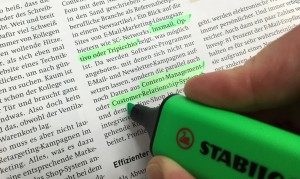7. September 2015
Giving media analysts some free space

Benefits of automatic text summarization in Media Monitoring and Media Response Analysis
It is the year 2015: Your company has just released a brand new product called “alpha” and you are wondering who’s talking about and what people are thinking about it. You wonder how should figure this out? Thanks to search enginges like Google it should not be a problem, you think. You start searching for “alpha” … but get disappointed immediately.
Google returns over 400.000.000 hits, a long list of news articles, blog posts, social media postings and more. The majority of the hits yuo find are not even relevant to your product. After all, “alpha” is not a rare product name. Continuing your research to find a solution for your problem, you come across a professional “Media Monitoring” company offering “Monitoring Services” and “Media Response Analysis”. It sure sounds great, but what on earth does that mean (and will it help you)?
Media Monitoring
The described scenario is an example for the enormously increased amount of available information these days. Thanks to the internet, it is becoming more and more of a challenge for many individuals and companies to find and access their required information. This is exactly the place where professional media monitoring service providers come in with their portfolio.

Highlighting Keywords
The goal in Media Monitoring is to gather the relevant information to a specific topic, product, company or organization from various inhomogeneous channels. To accomplish this task, Media Monitors and their clients define a set of keywords to focus the search and to automatically remove irrelevant information. As in every automatic system, it could be the case that the automatic filtering does not return the ideal results. This is again more likely today as more and more information is available. Due to this ‘noise’, the quality of the filtered information will be manually controlled and improved in an additional step by media analysts working at the media monitoring service.
Media Response Analysis
After gathering the relevant information needed to answer the customer’s questions based on keywords, a deeper analysis of the information is necessary. What do people think about “alpha”? Do they write rather positive or negative about it? What do my competitors think about the new product? The answer to these and similar questions can be found in Media Response Analysis.
The primary goal of Media Response Analysis is to identify and evaluate the statements made on the organization, companies and their products/services. This process is usually done manually by experienced media analysts and results in the creation of comprehensive reports for the customers. The reports contain information such as the relevant statements together with their tonality (positive, negative, neutral) or summaries of the analyzed information.
Although many of the activities performed by the media analyst are done automatically by means of computers, still an immense amount of time is invested for reading the texts and writing text summaries (abstracts and reports). Much of the work of the media analysts is attributable to the simultaneous reading and processing of information that is irrelevant to the customer. Experience shows that a maximum of 35% of the filtered information, are actually relevant for the customer. Nevertheless, all articles are equally relevant for the media resonance analysis and must be fully read.
Automatic Text Summarization
Automatic text summarization is a field of computer science aiming to produce human-readable summaries out of digital documents. The research in automatic text summarization goes back to the 1950s and and ongoing field of scientific activity until today. The task of automatic text summarization is considered as a tough challenge, as the algorithms have to first understand the text to be summarized, then select the most important information out of it and finally represent the significant information in form of coherent sentences that are readable to humans.

Office helper: Robots writing texts
As already mentioned, the media analysts invest a huge amount of time in reading and analyzing textual information manually, to find out which are relevant to the customer and which are not. Automatic text summarization is considered as a possible solution to reduce the amount of invested time and accordingly decrease the costs.
In media monitoring, automatic text summaries play a decisive role in two ways: First, they reduce the amount of texts to be read during the media monitoring. Second, they serve the analysts as the backbone for the summaries, which are delivered to the customer within the analysis reports.
Even with the aid of an automatic text summarization system the daily work of media analysts will still be extremely complex and time consuming. The difference, however, is that they no longer need to read plenty of textual contents, of which a large part is irrelevant. Instead, they can concentrate on a compressed and summarized text version, filtering out what’s relevant and then dive deeper into what has a very high content of relevant information. Additionally the analysts have the opportunity to concentrate on the essentials, so the time required for reading is reduced, allowing them for more in depth analysis, also increasing their motivation and concentration.
Photo Credit:
- Feature Image “Recycling” by Sharla Sava on Flickr – Licenced under creative commons, slightly cropped to fit this page.
- Picture “office helper” by Tony Delgrosso on Flickr – Licenced under creative commons

